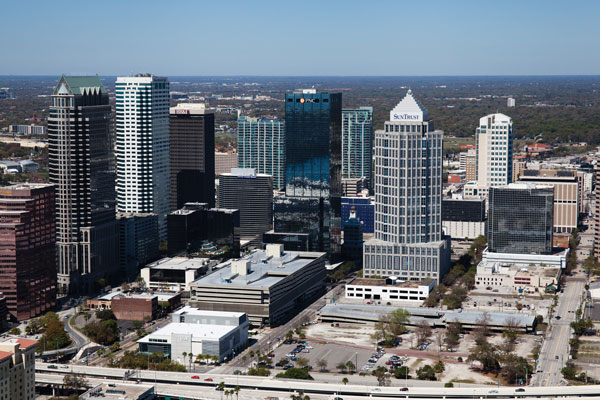
Tampa City Center was already fairly energy efficient, but each year they chip away at their usage, replacing light fixtures with LED, adding additional variable speed drives, or upgrading outdated HVAC equipment with more energy efficient options. Photo: Mark Gall
One trait common among TOBY winners is having pushed sustainability measures forward long before it was trendy to do so. It shows that it’s part of the organization’s culture, not just a publicity stunt. The 39-story Tampa City Center was the tallest building in the state when it joined the skyline of this balmy Gulf of Mexico port in 1981. Probably less reported in the media was that it was the first multitenant office building in the city to adopt a whole building recycling program—not earth-shattering news today, but the staff was quite proud when they pulled that off in 1992.
“Other corporate offices could do that when they had only one tenant, but for a multitenant office building, it was pretty unique in the early ’90s to find a program in place for tenants to do desk-side recycling,” says Sandy Ballestra, the general manager at Tampa City Center for Cushman and Wakefield, who joined the staff during that period. “Long before LEED, we always had very innovative staff that wanted to do things that were good for the environment, good for the building, and reduced operating expenses.”
 Tampa City Center achieved LEED Gold for operations and maintenance in 2010, a push that Ballestra herself helped to organize after becoming a LEED Accredited Professional in 2008, but she says the difference between “where we were and what we would need to do to achieve certification was minimal.” For example, the building’s engineers reconfigured the HVAC system to recycle condensate water nearly 30 years ago. During the heat of the summer, 5,000 gallons of condensate is recovered from the air handlers each day and fed back into the system, where formerly fresh potable water was used.
Tampa City Center achieved LEED Gold for operations and maintenance in 2010, a push that Ballestra herself helped to organize after becoming a LEED Accredited Professional in 2008, but she says the difference between “where we were and what we would need to do to achieve certification was minimal.” For example, the building’s engineers reconfigured the HVAC system to recycle condensate water nearly 30 years ago. During the heat of the summer, 5,000 gallons of condensate is recovered from the air handlers each day and fed back into the system, where formerly fresh potable water was used.
Then, about 12 years ago, a drought provoked the idea of capturing water from the French drain system around the building’s foundation to irrigate the landscaping, which is comprised of mostly native Floridian plants. Two 500 gallon hot water tanks were being replaced at the time, which were handily repurposed as cisterns. Today, the system collects more than 4 million gallons annually, supplying 100% of the site’s irrigation water. Only a portion of the water collected is needed for irrigation, so the rest is returned to the aquifer beneath the city.
“It just shows what forward thinkers the engineers at this building are,” Ballestra says. Even though massive upgrades weren’t required to achieve LEED Gold, she certainly appreciates the rigorous documentation required by the LEED application. “We’d been doing some of these things for a long time but didn’t have the written policy that LEED requires. So we learned a lot about the building in the process. It’s easy to operate your building in a sustainable manner; it just makes sense to do it that way.”
Tampa City Center was already fairly energy efficient, but each year they chip away at their usage, replacing light fixtures with LED, adding additional variable speed drives, or upgrading outdated HVAC equipment with more energy efficient options. They’ve set a minimum benchmark of lopping off 1% of energy use each year, which they’ve more than reached since they first tracked baseline data in 2008.

Photo: Mark Gall
But the pride of the building continues to be its recycling program. What started with desk-side bins to recycle office paper in 1992 has expanded to a multi-faceted program where tenants can recycle everything from bottles and cans to cell phones and computers to furniture and light bulbs. Green waste from the outdoors is composted onsite to create rich compost for the plantings. Several years ago, management made a simple, but high impact change to those desk-side recycling bins: no more plastic liners. The change resulted in more than doubling the annual recycling total from 54 tons diverted up to 136 tons each year. In total, 51% of the waste stream at Tampa City Center is diverted from the landfill.
After all those years of hard work, the staff certainly deserves some credit. They achieved the BOMA 360 designation in 2010 and have won several TOBY awards in other categories before, but last year they won regionally in the Earth category. And now they are up for the International TOBY Earth award. “We thought it would be reasonable to pursue that,” says Ballestra with characteristic humility.
Download a PDF of this story here.

